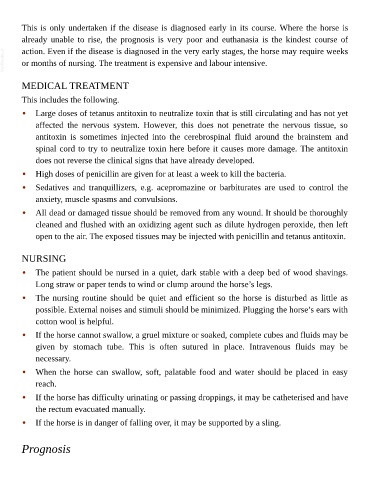Page 500 - The Veterinary Care of the Horse
P. 500
This is only undertaken if the disease is diagnosed early in its course. Where the horse is
already unable to rise, the prognosis is very poor and euthanasia is the kindest course of
VetBooks.ir action. Even if the disease is diagnosed in the very early stages, the horse may require weeks
or months of nursing. The treatment is expensive and labour intensive.
MEDICAL TREATMENT
This includes the following.
• Large doses of tetanus antitoxin to neutralize toxin that is still circulating and has not yet
affected the nervous system. However, this does not penetrate the nervous tissue, so
antitoxin is sometimes injected into the cerebrospinal fluid around the brainstem and
spinal cord to try to neutralize toxin here before it causes more damage. The antitoxin
does not reverse the clinical signs that have already developed.
• High doses of penicillin are given for at least a week to kill the bacteria.
• Sedatives and tranquillizers, e.g. acepromazine or barbiturates are used to control the
anxiety, muscle spasms and convulsions.
• All dead or damaged tissue should be removed from any wound. It should be thoroughly
cleaned and flushed with an oxidizing agent such as dilute hydrogen peroxide, then left
open to the air. The exposed tissues may be injected with penicillin and tetanus antitoxin.
NURSING
• The patient should be nursed in a quiet, dark stable with a deep bed of wood shavings.
Long straw or paper tends to wind or clump around the horse’s legs.
• The nursing routine should be quiet and efficient so the horse is disturbed as little as
possible. External noises and stimuli should be minimized. Plugging the horse’s ears with
cotton wool is helpful.
• If the horse cannot swallow, a gruel mixture or soaked, complete cubes and fluids may be
given by stomach tube. This is often sutured in place. Intravenous fluids may be
necessary.
• When the horse can swallow, soft, palatable food and water should be placed in easy
reach.
• If the horse has difficulty urinating or passing droppings, it may be catheterised and have
the rectum evacuated manually.
• If the horse is in danger of falling over, it may be supported by a sling.
Prognosis

